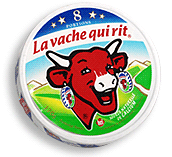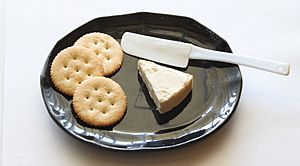The Laughing Cow facts for kids
Quick facts for kids La Vache qui Rit (The Laughing Cow) |
|
|---|---|
 |
|
| Other names | Laughing Cow Cheese |
| Country of origin |
|
| Region | Lons-le-Saunier |
| Source of milk | Cow |
| Pasteurised | Yes |
| Texture | Semi-soft |
| Aging time | Made from aged cheeses, but not aged itself |
| Certification | Trademarked brand name |
| Named after | Lua error in Module:Wikidata at line 70: attempt to index field 'wikibase' (a nil value). |
The Laughing Cow (French: La vache qui rit) is a famous brand of processed cheese products. It has been made by a company called Fromageries Bel since 1921. The most well-known product from this brand is the spreadable cheese wedge.
Contents
What is The Laughing Cow Cheese?
This cheese is a mix of cream, milk, and both fresh and aged cheeses. One of the aged cheeses used is comté. These ingredients are then pasteurized. This means they are heated to kill germs and stop the cheese from aging further.
Because it is pasteurized, Laughing Cow cheese is very handy. It can stay fresh for a short time even without being in a fridge. The classic Laughing Cow cheese comes in small, individual wedges wrapped in foil. These wedges are packed in a round, flat box. To open the box, you pull a small red thread around it. The foil wrapper on each wedge also has a red tab to help you open it easily.
The Laughing Cow cheese comes in many forms around the world:
- Small triangles, squares, or rectangles with different tastes.
- Cheese spreads in tubs and jars.
- The Laughing Cow Dip & Crunch (also called Pik & Croq). These are snacks with bread sticks and cheese spread. They come in different flavors like original, light, hazelnut, and pizza.
- Larger blocks of Laughing Cow cheese that are firmer, like butter, for slicing.
- Ma P'tite Vache Qui Rit, which are small pods of cheese spread. These are made for younger children to eat with a spoon.
- Toastinette processed cheese slices, similar to other popular cheese slices.
- Small, bite-sized cubes that come in many flavors. These are often served as snacks at parties. They have different names like Cheez & Fun in Europe, Snack Bites in the UK, and Apéricube in France. They can be found in boxes of one flavor, like blue or ham. You can also find boxes with a mix of flavors, like 'Cocktails du Monde'.
Some types of Laughing Cow products are no longer made:
- Giggles/Blop cheese pods for young children.
- Cheese in squeeze bottles.
- Larger versions of the Dip & Crunch snacks.
- Snacks that included crispy bacon flavor bits with the cheese and bread sticks.
In 2009, The Laughing Cow USA started a TV ad campaign with a new saying: "Have you laughed today?". They also updated their website in 2010 to share cheese recipes.
Laughing Cow cheese is available in its original flavor. There are also lighter versions with less fat. You can also find many flavored versions of the cheese. These include ham, gruyère, garlic, paprika, mushroom, chèvre, bleu, hazelnut, pizza, jalapeño, and onion. These flavors are available in different countries.
How the Laughing Cow Brand Changed
The Laughing Cow is known for its red and white cow mascot. The cow always looks happy and wears ear tags that look like the round cheese boxes.
On April 16, 1921, Léon Bel officially registered his brand in France. He called it La Vache Qui Rit, which means "The Laughing Cow." In the official papers, the cow was described as having a "hilarious expression." Léon Bel drew the first picture himself. He got the idea from a meat wagon he saw during World War I. It was called "La Wachkyrie", which was a play on words for Valkyrie.
At first, the cow in the drawing was not laughing. It was not red, and it did not have ear tags. This was the very first branded cheese product ever registered in France! In 1924, an artist named Benjamin Rabier changed the drawing. He made it look more like the happy cow we see today. The blue and white stripes around the box were added in 1955. Since 1976, both ear-tag boxes on the cow have been shown with their top side visible. Before that, one showed the top and one showed the bottom. The current logo uses the Droste effect. This is where the laughing cow appears inside the ear tags, and then that image appears inside the ear tags again, and so on.
Kiri is another cheese brand that the Bel company started in 1966. Its name sounds similar to "qui rit."
The Laughing Cow Around the World
This cheese has been very popular in the United Kingdom and Canada for a long time. Kids there often eat it as a snack. In the United States, it was not as popular for many years. However, more people have started buying the triangular wedges recently. This is because the light version of the cheese was suggested as a good food choice for people following the South Beach Diet.
In France, people often ask, "Pourquoi La Vache Qui Rit rit?" This means "Why is The Laughing Cow laughing?" This question has become very famous with the product.
The product has different names in many countries where it is sold:
- La Vache qui Rit in France, Switzerland, Belgium, and many Arabic-speaking countries.
- The Laughing Cow in English-speaking countries.
- Die Lachende Kuh in German-speaking countries (except Switzerland).
- La Vaca que Ríe in Spanish-speaking countries.
- A Vaca que Ri in Portuguese-speaking countries.
- Весёлая Бурёнка in Russia.
- ラッフィングカウ in Japan.
- 乐芝牛 in China.
- 笑牛牌 in Hong Kong.
- La Mucca che Ride in Italy.
- Den Skrattande Kon in Sweden.
- Den Leende ko in Denmark.
- Gülen İnek in Turkey.
- Krówka Śmieszka in Poland.
- Nevető tehén in Hungary.
- Văcuța veselă in Romania.
- Krava koja se smije in Croatia.
- Весела Корівка in Ukraine.
- Veselá kráva in the Czech Republic.
- Η Αγελάδα που Γελά in Cyprus.
- گاو خندان in Iran.
- Sapi Ceria in Indonesia.
- Con Bò Cười in Vietnam.
- Ilay Omby Vavy Mifaly in Madagascar.
See also
 In Spanish: La vaca que ríe para niños
In Spanish: La vaca que ríe para niños


